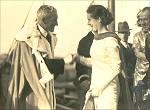 | Caithness.Org | Community | Business | Entertainment | Caithness... | Tourist Info | Site Map |
• Advertising • Chat Room • Contact Us • Kids Links • Links • Messageboard • News - Local & Scottish • News - UK & News Links • About / Contact Us • Submissions |
• Bookshop • Business Index & News • Jobs • Property For Sale • Property For Rent • Shop • Sutherland Business Index |
• Fishing • Fun Stuff • George, The Saga • Horses • Local Galas • Music • Pub Guide • Sport Index • What's On In Caithness |
• General Information • B & Bs • Backpackers • Caravan & Camping • Ferries • Getting Here • Holiday Letting • Hotels • Orkney • Pentland Firth • Sutherland • Taxis |
| N E W S F E E D S >>> |
Herring Queens
If you spot any errors or have
additional information on any of the pictures please let us know.
| Wick
8 January 07
1938
Alice Taylor Newspaper Photo
1937 Rachael "Retta" Sinclair
Shearer
Isobel Cormack
was the 3rd Herring Queen and she was crowned in 1939.
|
Wick Herring Queen
Ceremony and Procession Another factor was that the fishing in Wick had been very bad for the previous six years and the fishing fleet had dwindled to a handful of boats. the Herring Queen committee resolved to try to bring a little pageantry and cheer to the town and organised a festival which succeeded beyond their most optimistic hopes. A girl, who to begin with, had to have at least one parent connected with the herring industry, was elected Queen on the day of her crowning, which took place at the Braehead, she was taken to sea on a drifter, escorted by as many of the fleet as wished to join. they carried passengers and the flotilla went as far as the mouth of Wick Bay where they turned to present a very impressive spectacle as they steamed in convoy back to the harbour. while the exact number of spectators was not counted, about 8000 people watched the arrival of the first Herring Queen. On landing she was greeted by the Provost and other dignitaries, escorted to the crowning platform, where the crown was placed on her head by the previous year's Queen. The crown itself is made of tinned copper with Ensign Armorial of Wick surrounded by symbols of the town's connection with the sea and the fishing industry. The ensignia is surrounded by a rope, supported by two dolphins and is leaning on crossed tridents. the frame of the crown is in the form of a net, with herring superimposed, a design drawn from the arms of the Burgh of Pulteneytown, which lies on the south side of the river and amalgamated with Wick in 1901, when the ceremony was over a procession of decorated lorries and carts went through the main streets of the town to gather money for local causes. Many local organisations took part in the parade and this tradition is still carried on the Queen was elected for a year and in this capacity she attended many local functions during that period, opening sales of work, garden fetes and other fund-raising activities. there were no festivals from 1939 to 1949 but by then the herring fishing in Wick was in terminal decline. the last Herring Queen was elected in 1953, the same year as the herring fishing ceased in the traditional way. The organisers saw no point in holding a Herring Queen ceremony when no herring were being landed, so the committee was dissolved and responsibility passed back to the Town Improvements Committee, who changed the name to Gala Queen and continue to hold this ceremony and procession in July every year. It is still one of the largest in Scotland. The Crown, cup and cloak loaned by Wick Riverside and Town Improvements Committee on 20th September 2000 is on display at Wick Heritage Museum.
Wick's Herring Queens After 1953 the ceremony became the Gala Queen Procession and a display will be created at a future date in the Wick Heritage Museum when space is available. Note - This text is taken from notes in the Wick Heritage Museum where a collection of memorabelia, programmes etc is on display. |














 This event was first held
in 1937 and was organised by a sub-committee of The wick Riverside and
Town Improvements which has been in existence since the reclamation of
tidal lands in the centre of the town early in the twentieth century.
the idea seems to have come from the Coronation of King George V1, which
had been held earlier the same year, and the fact that there was nothing
in the form of pageantry on the north Scottish mainland.
This event was first held
in 1937 and was organised by a sub-committee of The wick Riverside and
Town Improvements which has been in existence since the reclamation of
tidal lands in the centre of the town early in the twentieth century.
the idea seems to have come from the Coronation of King George V1, which
had been held earlier the same year, and the fact that there was nothing
in the form of pageantry on the north Scottish mainland.





